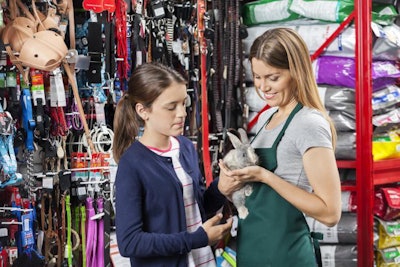
Sales for all pet products and services totaled US$103.5 billion globally in 2016, surpassing the US$100 billion mark for the first time. That represented a 4.7 percent increase over 2015, a growth rate that stands out among other consumer packaged goods industries, said Jared Koerten, lead analyst for Euromonitor International.
Koerten presented data on the global pet care and pet food markets during the American Feed Industry Association’s (AFIA) 10th annual Pet Food Conference, held January 31 in conjunction with the 2017 International Production & Processing Expo (IPPE) in Atlanta, Georgia, USA. Among product categories, he singled out dry dog food as the largest globally, racking up nearly US$30 billion in sales and growing 4.6 percent a year. It accounted for almost 40 percent of the US$75.25 billion global pet food market.
Focusing on the US, by far the largest pet care market globally and still increasing about 4 percent a year, Koerten said the average US household spends US$355 annually on pet care – a stark contrast to the global average of US$50. Yet the US' dominance comes with a caveat, especially where pet food is concerned: all the growth is in value sales, not volume sales, which are actually declining.
Why? In a word, premiumization, which includes higher-priced pet foods in both traditional formats (dry and wet) as well as newer, higher-density, fast-growing ones like freeze-dried and dehydrated. Nearly all the pet food sales growth in the US is coming from premium products, which comprise at least half the market in North America, according to Euromonitor.
Certain product categories, such as therapeutic pet foods and treats, are also among the top growers, and these products tend to cost more per pound. Another factor is the growing popularity of smaller dogs, which now account for over 40 percent of dogs owned in the US, Koerten said.
US pet food exports on the decline
While Koerten’s message and outlook on pet food were generally positive, other speakers at the AFIA conference issued words of caution, especially Gina Tumbarello, AFIA’s director of international policy and trade, who shared data showing that US pet food exports have lost market share, ranking and volume since 2011.
Once the second largest pet food exporter globally, behind only France, the US has now slipped to number three, behind Germany, Tumbarello said. Shares of the global pet food export market among those countries are 14.5 percent for France, 10.5 percent for Germany and 9.5 percent for the US, plus 8.9 percent for the Netherlands. The US’ share has declined from 11.4 percent in 2011. From that year through 2015, US pet food exports dropped by 11 thousand metric tons (TMT), representing a decrease of US$32 million in value.
With the Netherlands so close behind the US, Tumbarello wondered if the latter might slip to number four within the next year or two. She cited several reasons for that possible scenario, including changes and uncertainty over US trade policy and agreements under the new Trump administration. For example, in 2015, the US exported 286 TMT of pet food to countries that had signed on to the Trans-Pacific Partnership (TPP), the pending agreement from which President Trump just withdrew the US. That volume of pet food represented nearly US$1 billion in value.
(Note that, separately during IPPE, Tumbarello’s boss, AFIA president/CEO Joel Newman, expressed optimism at working with the Trump administration, despite AFIA’s concern over the TPP withdrawal.)
Finding the next pet food employees
Another interesting session during AFIA’s pet food conference was on finding the next generation of pet food employees. Jessica Starkey, PhD, an assistant professor of agriculture at Auburn University, spoke about the need for organizations in pet food, feed, agriculture and science to find new staff and, specific to pet food, for companies to communicate that the industry is even a possible career.
Her main recommendation was to educate the educators: let university programs and faculty know which positions are open, the specific education, training and skills needed for those positions and details on what employees in those positions would be doing. “How do you communicate how engineering, nutrition, food science, agriculture information and degrees work with pet food? Where are the connection points?” were among the questions that Starkey posed to pet food professionals in the audience.
And, don’t rely on HR to make the connections or write job descriptions for you, she said; only functional staff truly understand those positions and what they entail. In addition, job descriptions need to be written in a way that that will connect with today’s students, especially centennials/generation Z (born from 1995 to 2012).
Comments from the audience included the point that educating the educators shouldn’t be limited to colleges and universities, but should be pushed down to the high school and even middle school level, before students started considering potential careers and college majors.
This topic will be among several addressed via informal, roundtable lunch discussions during Petfood Forum on Wednesday, April 5.

















